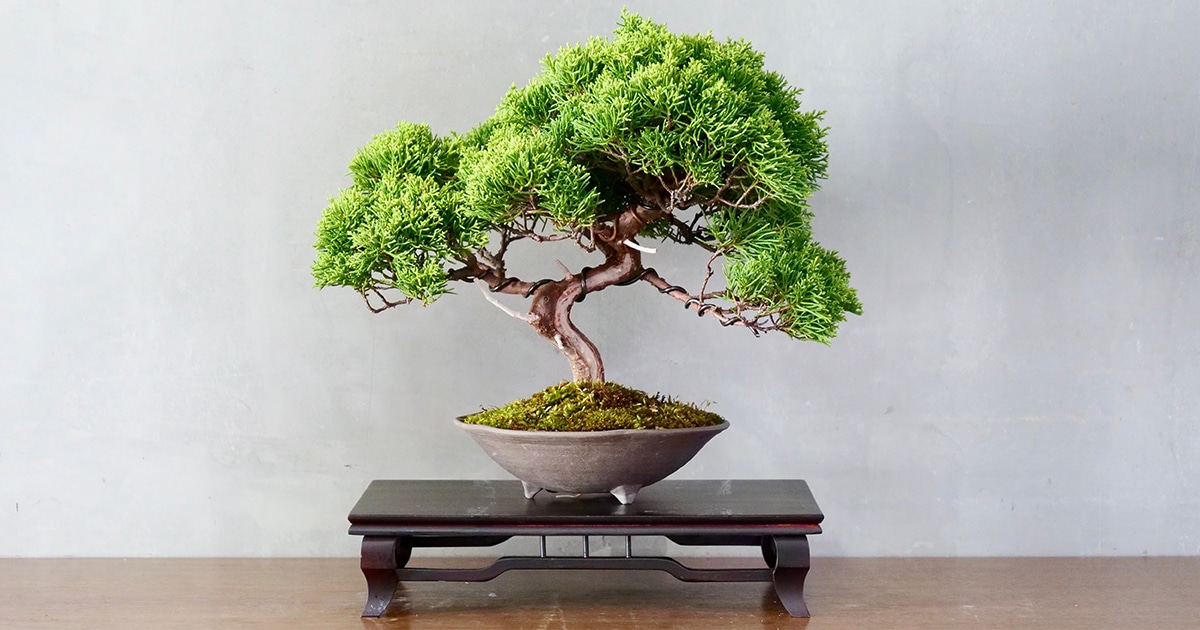Home>Gardening News and Trends>Latest News>What Does A Bonsai Tree Symbolize


Latest News
What Does A Bonsai Tree Symbolize
Modified: January 22, 2024
Discover the latest news on the symbolism of bonsai trees and their cultural significance. Learn about the deep meaning behind these miniature masterpieces.
(Many of the links in this article redirect to a specific reviewed product. Your purchase of these products through affiliate links helps to generate commission for Chicagolandgardening.com, at no extra cost. Learn more)
Table of Contents
Introduction
The Art and Symbolism of Bonsai Trees
When one thinks of a bonsai tree, a vision of a miniature, perfectly pruned tree often comes to mind. These exquisite living sculptures have captivated the hearts and minds of people around the world for centuries. The art of cultivating and nurturing bonsai trees has deep cultural and spiritual significance, offering a window into the harmony between nature and human intervention.
Exploring the world of bonsai trees unveils a rich tapestry of history, symbolism, and cultural significance. From their origins in ancient China to their revered status in Japanese culture, bonsai trees have transcended time and borders, embodying profound meanings that resonate with enthusiasts and spiritual seekers alike.
In this article, we will delve into the captivating world of bonsai trees, exploring their history, symbolism, and cultural significance. By understanding the essence of these miniature marvels, we can gain a deeper appreciation for the artistry and spiritual symbolism they embody.
History of Bonsai Trees
The history of bonsai trees is a tale of ancient horticultural artistry and cultural exchange. The practice of cultivating miniature trees can be traced back over a thousand years to the Tang dynasty in China, where it was known as “penjing.” The Chinese art of penjing involved creating miniature landscapes, including trees, rocks, and water features, to evoke the essence of nature in a confined space.
During the Kamakura period in Japan (1185-1333), Japanese monks studying in China brought back the art of penjing, which evolved into the Japanese art form known as “bonsai.” The term “bonsai” translates to “planted in a container” or “tray planting,” reflecting the meticulous care and attention given to these miniature trees.
Over the centuries, bonsai cultivation in Japan evolved from being primarily associated with the elite and the aristocracy to becoming a widely practiced art form accessible to people from all walks of life. The Japanese refined and elevated the art of bonsai, infusing it with philosophical and spiritual significance, such as the concept of “Wabi-Sabi,” which embraces imperfection and impermanence.
During the 13th and 16th centuries, the Japanese Zen Buddhists played a pivotal role in shaping the aesthetics and philosophy of bonsai, emphasizing harmony, balance, and the expression of the natural world within the confines of a small container. This spiritual connection to nature is a defining characteristic of bonsai trees, as they are revered as symbols of tranquility, longevity, and the interconnectedness of all living things.
Today, the art of bonsai has transcended its Asian origins and has gained global popularity, with enthusiasts and practitioners from diverse cultural backgrounds embracing its meditative and artistic qualities. The history of bonsai trees stands as a testament to the enduring allure of these miniature marvels and the profound cultural and spiritual significance they embody.
Symbolism in Bonsai Trees
Bonsai trees are not merely ornamental decorations; they are profound symbols that encapsulate a myriad of meanings deeply rooted in cultural and spiritual traditions. The art of cultivating and nurturing these miniature trees reflects an appreciation for the transient beauty of nature and the interconnectedness of all living things.
One of the key symbolic elements of bonsai trees is their representation of harmony and balance. The meticulous pruning and shaping of the trees embody the Japanese concept of “Wabi-Sabi,” which celebrates imperfection and impermanence. Bonsai trees are a visual expression of the harmonious coexistence between human intervention and the inherent beauty of nature.
Moreover, the longevity of bonsai trees symbolizes resilience, endurance, and the passage of time. These miniature trees, with proper care, can live for decades, serving as a testament to the strength and perseverance of life. In Japanese culture, bonsai trees are often presented as gifts to symbolize friendship, harmony, and good fortune, further emphasizing their symbolic significance in interpersonal relationships.
Bonsai trees also hold spiritual symbolism, particularly in Zen Buddhism, where they are revered as a representation of the interconnectedness of all things. The meditative practice of cultivating and tending to bonsai trees fosters a sense of mindfulness and reverence for the natural world, aligning with the Zen philosophy of being present in the moment and finding beauty in simplicity.
Furthermore, the aesthetic appeal of bonsai trees evokes a sense of tranquility and contemplation. Their diminutive size and serene appearance invite observers to pause and reflect on the beauty and fragility of life, serving as a reminder to embrace the present moment and find peace amidst the chaos of the world.
In essence, bonsai trees symbolize a harmonious union between humanity and nature, embodying timeless virtues of resilience, interconnectedness, and contemplative beauty. Their symbolic significance transcends cultural boundaries, resonating with individuals seeking to connect with the profound wisdom and tranquility encapsulated within these living works of art.
Cultural Significance of Bonsai Trees
The cultural significance of bonsai trees spans centuries and encompasses a diverse tapestry of traditions, beliefs, and artistic expressions. Rooted in ancient Asian cultures, particularly in China and Japan, bonsai trees have become emblematic of profound spiritual, philosophical, and aesthetic values that resonate across the globe.
In Japanese culture, bonsai trees are revered as symbols of harmony, balance, and the enduring beauty of nature. The meticulous care and attention given to these miniature trees reflect the Japanese aesthetic principle of “Wabi-Sabi,” which celebrates imperfection and impermanence. Bonsai cultivation is not merely a horticultural practice but a meditative art form that fosters a deep connection to the natural world and the passage of time.
Moreover, bonsai trees hold a prominent place in Japanese festivals, where they are displayed as expressions of seasonal beauty and the cyclical rhythm of nature. During events such as the Hanami (cherry blossom viewing) and the Momiji-gari (autumn leaf viewing), bonsai trees serve as living embodiments of the transient yet enduring splendor of the changing seasons.
In Chinese culture, the art of penjing, which predates the Japanese bonsai tradition, holds its own cultural significance. The practice of cultivating miniature landscapes, including trees, rocks, and water features, reflects the Chinese reverence for nature’s harmony and the art of storytelling through living art forms. Chinese penjing often conveys moral and philosophical themes, serving as visual allegories that impart wisdom and contemplation.
Furthermore, the global appeal of bonsai trees has led to their integration into diverse cultural traditions, where they serve as symbols of peace, resilience, and the timeless beauty of the natural world. Bonsai exhibitions, workshops, and clubs have proliferated worldwide, fostering cross-cultural exchanges and mutual appreciation for the artistry and symbolism of these miniature marvels.
The cultural significance of bonsai trees transcends geographical boundaries, uniting people in their shared reverence for the art of cultivating miniature trees and the profound meanings they embody. As living symbols of harmony, resilience, and contemplative beauty, bonsai trees continue to enrich and inspire diverse cultural landscapes, nurturing a universal appreciation for the timeless wisdom encapsulated within their diminutive yet profound presence.
Bonsai Trees in Different Cultures
The allure of bonsai trees has transcended cultural boundaries, captivating the hearts and minds of enthusiasts across the globe. While the art of cultivating miniature trees originated in ancient China and Japan, it has found resonance in diverse cultural landscapes, each imbuing the practice with unique interpretations and expressions.
In Japan, the tradition of bonsai cultivation has evolved into a revered art form intertwined with the country’s cultural identity. Bonsai trees are deeply embedded in Japanese aesthetics, philosophy, and seasonal traditions, such as the celebration of cherry blossoms and autumn foliage. The meticulous care and shaping of bonsai trees reflect the Japanese reverence for nature’s harmony and the passage of time, making them an integral part of the country’s cultural tapestry.
In China, the art of penjing, which predates the Japanese bonsai tradition, holds its own cultural significance. Chinese penjing encompasses the cultivation of miniature landscapes, including trees, rocks, and water features, and often conveys moral and philosophical themes. The Chinese reverence for nature’s harmony and the art of storytelling through living art forms is reflected in the practice of penjing, showcasing the cultural depth and artistic expression inherent in the tradition.
Across the Western world, bonsai cultivation has gained widespread popularity, with enthusiasts embracing the art form and infusing it with their unique cultural perspectives. Bonsai trees have become emblematic of patience, mindfulness, and the appreciation of natural beauty, resonating with individuals seeking a deeper connection to the natural world and the meditative art of nurturing living sculptures.
Moreover, bonsai trees have found a place in diverse cultural celebrations and exhibitions, serving as symbols of peace, resilience, and the enduring beauty of nature. Bonsai enthusiasts from various cultural backgrounds come together to share their passion for these miniature marvels, fostering cross-cultural exchanges and mutual appreciation for the artistry and symbolism of bonsai cultivation.
As a living art form, bonsai trees continue to weave a rich tapestry of cultural expressions, transcending geographical borders and uniting people in their shared reverence for the timeless wisdom and contemplative beauty encapsulated within these diminutive yet profound living sculptures.
Conclusion
The art and symbolism of bonsai trees offer a window into the profound interconnectedness between humanity and the natural world, transcending cultural boundaries and resonating with individuals seeking tranquility, contemplation, and a deeper connection to the timeless wisdom encapsulated within these living sculptures. From their ancient origins in China to their revered status in Japanese culture, bonsai trees have evolved into a global symbol of harmony, resilience, and the enduring beauty of nature.
Exploring the history, symbolism, and cultural significance of bonsai trees unveils a rich tapestry of traditions, philosophies, and artistic expressions that have shaped the practice of cultivating and nurturing these miniature marvels. The meticulous care and shaping of bonsai trees reflect the Japanese aesthetic principle of “Wabi-Sabi,” celebrating imperfection and impermanence, while the Chinese tradition of penjing conveys moral and philosophical themes through miniature landscapes.
Furthermore, the universal appeal of bonsai trees has led to their integration into diverse cultural traditions, where they serve as symbols of peace, mindfulness, and the timeless beauty of the natural world. Bonsai cultivation has become a meditative art form that fosters a deep connection to the transient yet enduring splendor of nature, enriching and inspiring diverse cultural landscapes across the globe.
In essence, the art and symbolism of bonsai trees transcend geographical boundaries, uniting people in their shared reverence for the profound meanings and contemplative beauty encapsulated within these diminutive yet profound living sculptures. As living symbols of harmony, resilience, and interconnectedness, bonsai trees continue to nurture a universal appreciation for the timeless wisdom and tranquility they embody, inviting individuals to pause, reflect, and find solace in the enduring beauty of the natural world.


